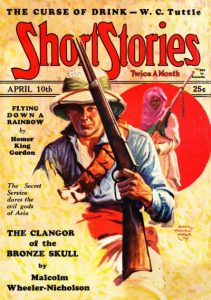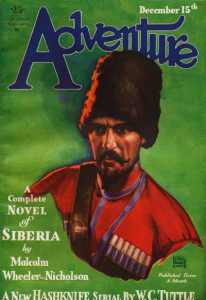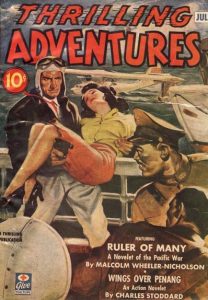Pulp magazines have influenced writers, artists, film directors, software developers, and countless others over the years. Our “PulpFest Profiles” focus on contemporary creators who have drawn inspiration from these rough-paper fiction magazines.
 Nicky Wheeler-Nicholson is the granddaughter of Major Malcolm Wheeler-Nicholson, author of roughly 154 pulp fiction stories. The founder of National Allied Publications, he published the first full-length comic book containing original material.
Nicky Wheeler-Nicholson is the granddaughter of Major Malcolm Wheeler-Nicholson, author of roughly 154 pulp fiction stories. The founder of National Allied Publications, he published the first full-length comic book containing original material.
For over two decades, Nicky has been researching her grandfather’s life, his pulp writing career, and his very important role in comic book history. The author of two books about her grandfather and his work, and a frequent guest and panelist at pop culture conventions, I recently checked in with Nicky to learn more about “The Major.”
Laurie Powers: Nicky, can you provide some background on your grandfather? What led him to become a writer? How did he wind up establishing a comic book publishing company?
Nicky Wheeler-Nicholson: My great-grandmother Antoinette was a writer. She also knew many leading authors, journalists, artists, scientists, and other thinkers of the time. MWN grew up in a household where writing, newspapers, and journalism were part of life.
He joined the army in 1911 and quickly rose through the ranks. His military career ended in 1922 by court-martial. The Major was declared innocent of all charges, except for one concerning a letter to President Warren Harding. Published by THE NEW YORK TIMES, it openly criticized the United States Army.
Following his honorable discharge from the Army, he began working for a newspaper syndicate and writing for magazines. As far as I know, MCCLURE’S published his first story, “The Wolves,” in their August 1924 issue. Three years later he began writing for the pulps, particularly ADVENTURE, ARGOSY, MYSTERY MAGAZINE, THE POPULAR MAGAZINE, SHORT STORIES, and THRILLING ADVENTURES. So successful as a pulp writer, he was able to move with his family to France until the 1929 stock market crash.
 Observing what sold well on newsstands, MWN decided to launch a hybrid magazine featuring original comics and a mix of stories and articles. He founded National Allied Publications in 1934, a phenomenal undertaking during the Great Depression. According to comic book pioneer Lloyd Victor Jacquet, it was thanks to my grandfather’s “quiet determination and resourcefulness” that Superman and DC Comics were born.
Observing what sold well on newsstands, MWN decided to launch a hybrid magazine featuring original comics and a mix of stories and articles. He founded National Allied Publications in 1934, a phenomenal undertaking during the Great Depression. According to comic book pioneer Lloyd Victor Jacquet, it was thanks to my grandfather’s “quiet determination and resourcefulness” that Superman and DC Comics were born.
LP: What led you to research your grandfather’s life and place in history?
NWN: My parents divorced when I was very young. I never met my grandfather, but my mother always spoke highly of him. I knew he was a writer and somehow involved with Superman.
When I moved to New York City, I reconnected with that side of my family. My father had saved a packet of letters and photographs for me. He wanted me to know “who I was.” The more I learned about “Nick” — as my grandfather is referred to in the family — the more I realized what a unique and forgotten historical figure he was. I identified with him as a writer and sympathized with him as someone largely forgotten by popular culture historians.
LP: Your first book, THE TEXAS SIBERIA TRAIL, is a collection of your grandfather’s pulp fiction stories. What binds these stories together? How did you select them?
 NWN: John Locke, the editor and publisher of Off-Trail Publications, is a remarkable writer and researcher. I was lucky to have his support. He put together a spreadsheet of my grandfather’s stories and we looked at a number of possibilities. It was such a collaborative effort that it’s hard to remember who came up with what. Together, we decided the book should follow the Major’s military career from his posting on the Texas-Mexico border to the Philippines, Siberia, and Europe.
NWN: John Locke, the editor and publisher of Off-Trail Publications, is a remarkable writer and researcher. I was lucky to have his support. He put together a spreadsheet of my grandfather’s stories and we looked at a number of possibilities. It was such a collaborative effort that it’s hard to remember who came up with what. Together, we decided the book should follow the Major’s military career from his posting on the Texas-Mexico border to the Philippines, Siberia, and Europe.
LP: You released DC COMICS BEFORE SUPERMAN: MAJOR MALCOLM WHEELER-NICHOLSON’S PULP COMICS in 2018. What led to this book?
NWN: In 2009, I began collaborating with a well-known writer on a biography of the Major. After seven years, we had not moved beyond a book proposal. When my collaborator’s life circumstances came to a head in a spectacularly public fashion in 2016, the book and I were part of the collateral damage. It was a very frustrating experience.
I was anxious to produce something after I had invested so much time and effort. Dan Herman of Hermes Press had approached me about publishing a book. Initially, I envisioned a collection of some of the Major’s pulp stories paired with their comic book adaptations. I thought it would be interesting to demonstrate their evolution from prose to graphic format.
Dan wanted to release the book at the 2018 San Diego Comic-Con. Thankfully, filmmaker and comics collector David Armstrong had a number of the original comics we wanted to use. He was kind enough to loan them to us for the project. Given the short time frame, I wrote an abridged biography of MWN’S life, incorporating some of his comic book stories to illustrate how his pulp fiction served as the foundation for the first original comic books.
LP: When the Major started National Allied Publications, how did he connect his pulp background to the idea he was developing — a comic book featuring original stories.
NWN: When I began researching MWN and his writing, my family gave me BATTLESHIELD OF THE REPUBLIC, a non-fiction book that he published in 1940. They also mentioned “trashy stories,” written to earn money. I had a hunch concerning the trashy stuff and kept looking for information about them. This was back in the 1980s. Fortunately, I was living in the Northeast and had access to excellent libraries and archives.
Eventually, I bought some of his pulp stories and was hooked. I fell in love with his pulp writing and wanted to read every story that he had written. After I began researching his comic books, I realized how much they had been based on his pulp work, both creatively and as a business concept. Most comic book scholars had no idea about the pulp connection.
 In a 1957 article, Lloyd Jacquet — the first editor of NEW FUN — stated that from the very beginning the Major intended to base many of his original comics on pulp fiction. “Major Nicholson’s pulp background helped here.” According to Jacquet, there was a bookshelf in the office that housed their ideas for new comics.
In a 1957 article, Lloyd Jacquet — the first editor of NEW FUN — stated that from the very beginning the Major intended to base many of his original comics on pulp fiction. “Major Nicholson’s pulp background helped here.” According to Jacquet, there was a bookshelf in the office that housed their ideas for new comics.
The Major’s pulp writing also helped to raise money to start publishing the comic books. His Bill Barnes stories for Street & Smith began running in early 1934. The first issue of NEW FUN was dated February 1935.
His first Barnes story, “Hawks of the Golden Crater,” also served as the basis for the “Bob Merritt and his Flying Pals” continuity that began in 1935. The second half of this story — originally published in MORE FUN — is featured in DC COMICS BEFORE SUPERMAN.
LP: One of the chapters from his life that you’ve thoroughly researched is how National Allied Publications was taken from him.
NWN: It’s a very complicated story. In debt to his distributor and printer, he never had complete financial control of his business. He was forced to relinquish more and more of the company just to pay people. During the 1938 bankruptcy proceedings, he and his young attorney were no match for Donenfeld’s and Liebowitz’s phalanx of lawyers and accountants. He told the court that he had been coerced. The legal documents certainly imply that was true.
LP: You quote correspondence between your grandfather and Jerry Siegel about Superman in DC COMICS BEFORE SUPERMAN. The content of the correspondence suggests that your grandfather wanted to publish Superman.
 NWN: MWN was one of the first publishers to see a drawing of Superman. My father, uncle, and aunts all remembered discussions about Superman at the family dinner table. They saw examples of the comic and were asked to share their opinions. My grandfather was the first to suggest that Superman should have his own comic book and that it should be in color.
NWN: MWN was one of the first publishers to see a drawing of Superman. My father, uncle, and aunts all remembered discussions about Superman at the family dinner table. They saw examples of the comic and were asked to share their opinions. My grandfather was the first to suggest that Superman should have his own comic book and that it should be in color.
When it became clear in early 1938 that he was going to lose his company, it was a huge blow. After Superman appeared in ACTION COMICS on April 18, 1938, my grandfather refused to speak on the subject. I’ve had to use other sources to reconstruct those years of his life.
The things that happened to Siegel and Shuster involving the Superman copyright took place while Donenfeld and Liebowitz were actively seeking to gain control of National Allied Publications. Unfortunately, the stories of the other people involved — Max Gaines, Sheldon Mayer, Joe Schuster, Jerry Siegel, and Vincent Sullivan — do not completely agree. Looking at such information as the bankruptcy proceedings and the letters from Liebowitz to Siegel, I’ve been filling in some of the holes.
LP: Following the loss of his comic book company, I understand the Major went back to writing for the pulps, in particular, THRILLING ADVENTURES and Standard Magazines’ western pulps. How do you think these stories compare to his pre-comic book work?
NWN: Given his huge loss, it took him a while to recover. In addition to the pulps, he wrote several well-received non-fiction books and many articles on national and international politics prior to and during World War II.
 His pulp stories after the comics are reflective of the times. He had a couple of fun stories featuring Hugh DeLaney as a sort of “Indiana Jones” character. “Free France Marches,” in the October 1941 THRILLING ADVENTURES, is a terrific spy story. He continued to write swashbucklers but also wrote a number of westerns set in the post-civil war era. They’re very much 1940s “cowboys and Indians” types. I think his later writing is tighter, perhaps due to scripting for his comics. However, his post-comic prose fiction doesn’t seem biographically connected to his life.
His pulp stories after the comics are reflective of the times. He had a couple of fun stories featuring Hugh DeLaney as a sort of “Indiana Jones” character. “Free France Marches,” in the October 1941 THRILLING ADVENTURES, is a terrific spy story. He continued to write swashbucklers but also wrote a number of westerns set in the post-civil war era. They’re very much 1940s “cowboys and Indians” types. I think his later writing is tighter, perhaps due to scripting for his comics. However, his post-comic prose fiction doesn’t seem biographically connected to his life.
LP: What does the future hold? Any ideas on getting more of the Major into print?
NWN: Starting with NEW FUN #1, I’m writing a blog about each one of MWN’s comic books. My goal is to examine each comic book page by page and write about each issue.
According to DC Comics, the first NEW FUN was released on January 11, 1935. Last year, DC released a reprint of the issue, celebrating its 85th anniversary. I contributed an essay to the book. In keeping to the 85-year theme, I’ve written about all of the 1935 comic books and started the 1936 comics. You’ll find these posts on the Major’s website.
Lee Marrs and I are collaborating on a comic based on the Major’s “Sandra of the Secret Service.” It will be published in May 2021 through David Lloyd’s digital ACES WEEKLY. This summer, I’ll be releasing an audiobook of DC COMICS BEFORE SUPERMAN. I’m also part of a project concerning his 1925 – 27 newspaper syndicate and his “Great Adventures” comic series. I’m working to complete my biography of the Major, aiming for a 2022 release.
LP: Nicky, thank you so much for visiting with PulpFest. We hope to see you soon.
Malcolm Wheeler-Nicholson published his first story in 1924. His stories began appearing regularly in pulp magazines in 1927, particularly in general fiction magazines. “The Baldassare Ruby” ran in the July 5, 1930 ARGOSY, featuring cover art by Paul Stahr. “The Clangor of the Bronze Skull” appeared in SHORT STORIES for April 10, 1929, with cover art by Edgar Franklin Wittmack. ADVENTURE for December 15, 1929 featured his novella, “The Song of Death,” on its cover. The art was by Loyal Faunce. Very little is known about the artist.
In early 1934, Street & Smith debuted BILL BARNES, AIR ADVENTURER. Writing as George L. Eaton, the Major penned the first five adventures of the new pulp hero. His “Hawks of the Golden Crater” ran in the February 1934 issue, featuring cover art by Frank Tinsley. Wheeler-Nicholson would later adapt this novel to the graphic format. It would appear in his comic books NEW FUN and MORE FUN. The first issue of NEW FUN — dated February 1935 — featured cover art by Lyman Anderson.
Following his loss of National Allied Publications, Wheeler-Nicholson returned to writing to make ends meet. In addition to non-fiction, he penned many more stories for the pulps. Many sold to THRILLING ADVENTURES and Standard Magazines’ western pulps. His novella, “Ruler of Many,” appeared in the July 1943 issue of THRILLING ADVENTURES, featuring cover art by Ernest Chiriacka.
Nicky Wheeler-Nicholson’s collection of her grandfather’s pulp fiction, THE TEXAS SIBERIA TRAIL, is available through John Locke’s Off-Trail Publications. Her collection of his comic book stories, DC COMICS BEFORE SUPERMAN: MAJOR MALCOLM WHEELER-NICHOLSON’S PULP COMICS, is available through the Major’s website or by clicking the link above. Watch for her collaboration with cartoonist and animator Lee Marrs in David Lloyd’s ACES WEEKLY. You’ll find the Major’s website at majormalcolmwheelernicholson.com/.
Laurie Powers is the granddaughter of pulp author Paul S. Powers. She was introduced to the pulp community in 2007 through the publication of PULP WRITER: TWENTY YEARS IN THE AMERICAN GRUB STREET, her grandfather’s memoir of writing for the pulps. She has also edited several collections of her grandfather’s work in various genres, some featuring previously unpublished stories. Laurie is the author of QUEEN OF THE PULPS: THE REIGN OF DAISY BACON AND LOVE STORY MAGAZINE, published by McFarland Books in 2019. She also contributed the chapter, “Love on the Newsstands,” to IDW Publishing’s THE ART OF THE PULPS. A resident of Virginia, Laurie was honored in 2016 with the Munsey Award.







